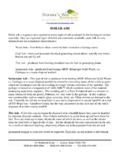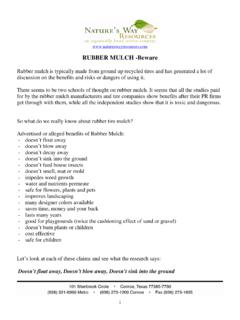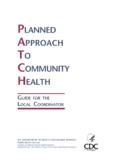Transcription of BROWN PATCH and TAKE-ALL PATCH - Warning Signs Brown …
1 PATCHand TAKE-ALL PATCH - Warning SignsIt is extremely well documented thatBrown Patchis caused by the soil borne fungus(Rhizoctonia solani) andTake-All Patchis caused by the fungusGaeumannomycesgraminis var. graminisboth of whichthrivein unhealthy soilsBROWN PATCH :Symptoms include yellowish grass with a grayish ring of wilted grass atthe edges of the PATCH , several inches to many feet across. Grass blades will easily pull offof stolons in the grayish area. The disease damages roots, stolons, and nodes. The diseasetends to start in the Spring and become bad in the Patchsurvives best inturfgrass with excessive thatch (healthy soils do not have thatch). It also occurs mostfrequently at daytime temperatures of 75-85 F with cooler nighttime temperatures(sometimes in the Spring but most common in the Fall).
2 However, we are now seeing brownpatch starting even during the hot cheap fertilizers (ammonium nitrate being the worst) tend to be strong acidifiers,whichcreate conditions that favor diseases likeBrown PATCH . Due to the high acidity thatdevelops from the use of these artificial fertilizers, farmers and gardeners often add ag-lime(crushed/powdered limestone of primarily calcite not dolomite).Note: In WW-II, the armymade run-ways over night by tilling in ammonium nitrate and limestone and adding a would set up almost like concrete in 24-48 hours. People today use the sameingredients and then wonder why they have hardpan and compaction PATCH This disease is generally found in St. Augustine and Bermudalawns. However, it will attack Bentgrass, Zoysia, Fescue, Perennial Rye and a few include yellowing and discolored leaves in the early stages to BROWN dead areasas the disease progresses.
3 Infected areas are generally rounded from several inches to manyfeet across but may be irregular in shape. Often the disease is misdiagnosed as irondeficiency or as chinch bug damage in Summer and treatingfor these problems actuallycauses the disease to spread faster. The disease damages roots, stolons, and nodes. Hencethe roots are short, often blackish and look rotted. Often a gentle pull will dislodge runnersfrom the soil due to the rotted roots. This disease is slow to get started and grass may beinfected up to two years before symptoms Patchoften starts in Spring andsurvives best in turf with excessive thatch (healthy soils do not have thatch).Take-AllPatchdevelops and growsbest in cool wet weather; however the symptoms often show later in hot dry grow better or even prefers alkalineconditions while BROWN PATCH prefers or grows better in acidic conditions.
4 Frequent shallowwatering causes the most problems. Much of our area water comes from wells that tend to bealkaline (lots of dissolved carbonates of calcium and magnesium), hence watering tends tocreate the alkaline conditions the disease favors. When we water the dissolved carbonates(limestone) will precipitate out of the water and cement the soil particles creating hardpanand raise the pH causing alkaline of InfectionOften new sod from grass farms is purchased and it is infected with the diseasesBrownPatchandTake-AllPatch. The sod farm uses large amounts of fungicides and other toxicchemicals which keep the disease dormant or suppressed so one does not see any visiblesigns When these extensive chemical treatments are removed, the disease wakes up andstarts to slowly grow, visibly showing up months or even years PatchandTake-All Patchare spread by landscape and lawn maintenancecompanies as they move their lawn mowers from yard to yard spreading the diseases.
5 Veryfew companies take precautions to clean and sanitize their equipment between each job third source of infection is from grass cuttings, trimmings from edging or soil particlesthat are blown into your yard by mechanical blowers from infected SignsThe questions we might ask ourselves are what causes unhealthy soils, are there anysymptoms or Warning Signs and how do we prevent (or cure) unhealthy soils?Researchers have observed several things aboutBrown PatchandTake All PATCH :-both thrivein soils that tend to be wet (over watered)-both prefer soils that are compacted-both require low levels of oxygen in the soils-both grow best in soils of low fertility or where the fertility is out of balance ( nitrogen)-both prefer cooler soil can now ask ourselves are there any Warning Signs that indicate we might have apotential BROWN or TAKE-ALL PATCH problem forming?
6 Most soil diseases are sort of like cancerin humans: they can be growing and developing long before visible symptoms is a group of plants that have evolved to live in the exact same conditions that favorBrown PatchandTake-All call themweeds. Disease organisms and plantspecies we call weeds are nature s way of fixing problems and getting rid of weak unhealthyplants (Survival of The Fittest) hence, researchers are now viewing weeds as a diagnostictool rather than as a common weed in our area that thrives in the conditions that favorBrown PatchandTake-All Patchis nutsedge or nut grass (Cyperus esculentus and Cyperus rotundus) whichare members of the sedge family. Most sedges have evolved to grow in bogs and swampsand to even standing water. Swamps and bogs are areas of low fertility, little oxygen in thesoil, and very wet conditions.
7 These type soils are dominated by bacteria with very littlefungi. However, healthy turfgrass, depending on the species, requires 30-50% beneficialfungi species in the soil. If we lose the good fungi then the stage is set for pathogens (badfungi) to move in and take we see nut grass in our lawns or gardens, it is telling us that the condition of our soil is atleast starting to favor nut grass NOT lawn grass. In other words our soils in our turf grasshave become compacted: there is little air (oxygen), the fertility is low or out of balance, andthe soil is too moist. When these conditions occur, the good soil microbes that prevent turfdiseases are dying off and the bad ones likeBrown Patchare waking up and starting to growand multiply. Using the human cancer analogy, if we detect an early skin cancer it can easilybe removed and prevented from spreading and becoming serious.
8 Similarly, at this stage it isrelatively easy and inexpensive to stopBrown PatchandTake-All Patchand turn backwards, we can ask ourselves; what did we do to cause these conditions? Thefirst major culprit is water soluble synthetic fertilizers with weed and feeds being theworst. A close second are the inexpensive (as in low quality) synthetic (artificial) fertilizersthat often release their nutrients quickly from thesaltsthey are made from (these also maycontain hazardous waste that create other long term problems). we use these types of fertilizers several things start to happen in our soil:-The excess nitrogen causes fast but very weak unhealthy salts kill the good microbes (remember we use salt in pickling to keep things fromrotting because it kills microbes).-The salts move downinto the soil and form glues that cement the soil particlestogether fertile soils have about 30 carbon atoms to every nitrogen atom, hence theexcess nitrogen creates an explosion of bacteria in the soils to absorb the quickly, the bacteria use carbon from the humus or soil organic matterdestroying it in the process; hence the soil quickly becomes bacteria also breathe air (oxygen), hence the soil becomesanaerobicas theair isused up far faster than it is microbes do not like oxygen, hence thepathogens wake up and start growing ( BROWN PATCH , TAKE-ALL , dollar spot, etc.)
9 -The salts also kill good microbes directly by sucking all the water out of their watering is the next problem. Since the soil structure has been damaged and theorganic matter destroyed, we now have conditions where the soil cannot drain; hence thepores are filled with water, making the lack of aeration worse (the soil cannot breathe).Without oxygen, roots start to die (grow only very shallow) and decay. The decay is causedby anaerobic microbes (fermenters) since there is no oxygen, hence alcohol is 1 ppm of alcohol will kill the roots of most plants further stressing andweakening thegrass. Additionally, the chlorine (or chloramine which are even worse) in the waterincreases the problems as it kills the remaining beneficial microbes and combines withsodium in the soil and/or cheap fertilizer to form more salt, resulting in more compaction andhardpan.
10 Recent research has found that chloramine cause lead and other heavy metals toleach from old pipes into the water. Besides being toxic to humans, these heavy metals cancause the soil to become out of balance nutritionally making the disease problems , because of the above problems our earthworms have died off. Earthworms aerate thesoil, they create soil structure to allow water and air to circulate, they eat weed seeds, andthey kill human pathogens frome-coli to cholera and salmonella. Earthworms also kill soilpathogens preventing them from becoming established and they produce plant root growthhormones. Additionally, earthworms also stimulate the growth of good microbes that fightdisease and help create good soil first step is the same as in medicine: Do No Harm! This means do not apply more lowquality synthetic fertilizer and stop or severely limit all forms of irrigation or from using syntheticchemical pesticides, fungicides, and herbicides.










